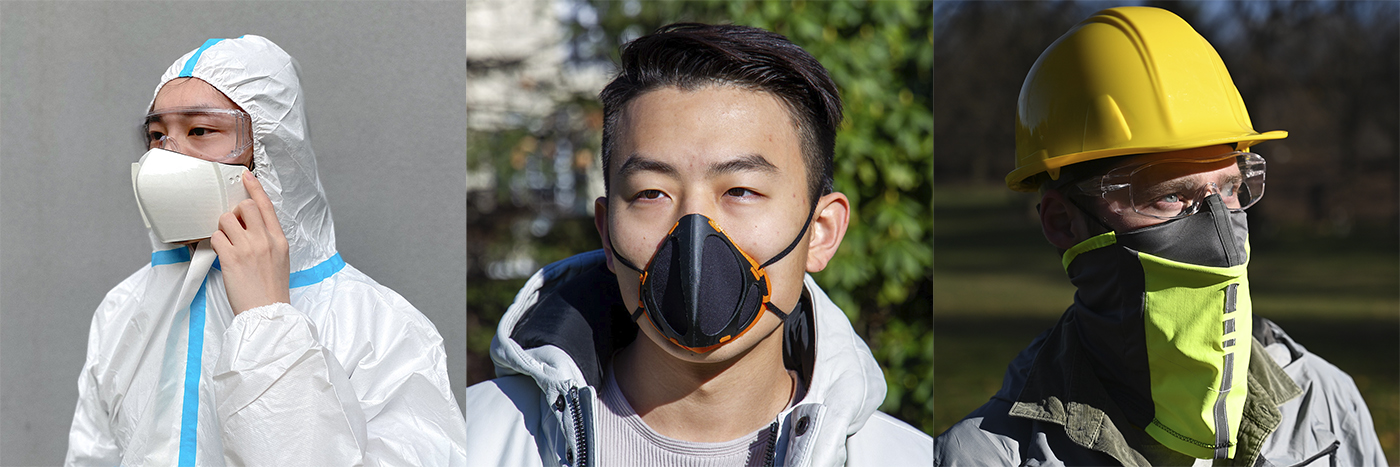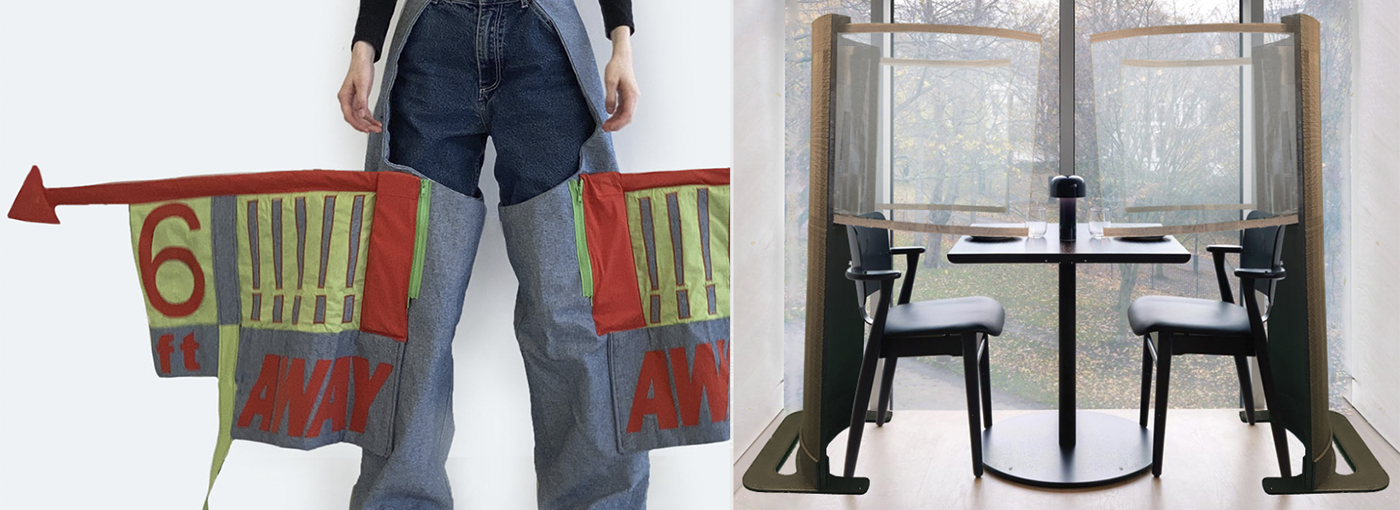
Designs for the Portable Environments Studio by Thomas Chen, Leo Zhang, and Daniel Jones
Almost a year into the COVID-19 pandemic and questions about how to best design for health and safety remain, such as how to advance the quality and effectiveness of masks and ways to protect hospitality workers as some cities return to indoor dining. Alongside is the need to make enduring solutions that can be adapted to evolving demands, whether potential future outbreaks or the annual flu season.
Last fall, the Portable Environments Studio led by Rebeccah Pailes-Friedman, adjunct professor-CCE of industrial design, explored functional apparel, wearable devices, and personal protective equipment (PPE) that could help reduce the spread of COVID-19. Considering clothing as a portable environment where its engineering and design can have built-in functions like protection from disease, they developed designs that would be mobile and use flexible textile-based materials.
“This studio class was the perfect platform for students to use their design skills to address the COVID-19 pandemic,” Pailes-Friedman said. “By studying the way people communicate and interact, the students found unique solutions that not only offer protection from the spread of the virus but also promote clearer communication and increase interaction between people, leading to an improved quality of life. Their work shows how the largest problems can be addressed with good design.”
Designing a Better Mask
The need for as many people as possible to wear effective masks is as crucial as it was last spring, but a large portion of the population is still wearing the cloth masks that were intended to be a stopgap design. There is an opportunity for high-grade, accessible masks designed for the specific needs of individuals and their work. Thomas Chen, BID ’21, prototyped a voice amplification mask for healthcare workers that would allow them to be audible to their coworkers and patients, a critical need when being understood can be a matter of life or death. Using recyclable, non-toxic materials that are durable and resistant to moisture, Chen’s mask meets the Centers for Disease Control and Prevention (CDC) requirements while containing an internal microphone.
Leo Zhang, BID ’21, also investigated improving masks, focusing on the needs of an active lifestyle. Many of the currently available masks can be difficult to breathe in when exercising and can trap sweat. Zhang concentrated on making a mask that was more comfortable and allowed for easier oxygen intake while still putting safety at the forefront. A modular design with a PLA outer shell, an interchangeable polyester filter, and a silicone inner shell provides a convex form that keeps the mask from changing shape when running or cycling.
Daniel Jones, BID ’21, likewise explored how a mask could be better designed for physically demanding situations. Recognizing that construction workers are often in close quarters for prolonged periods, and that many masks can cause protective glasses to fog, Jones created a lightweight mask with an elongated nose rest and adjustable metal bridge to offer a spatial barrier between the mouth and the fabric to prevent fogging. A filter pouch, adjustable features for all-day comfort, and high-visibility materials further support the needs of construction workers.
Solutions for Social Distancing

Designs for the Portable Environments Studio by Alena Gukova and Tia Hrubala
One of the best measures to mitigate the spread of COVID-19 is staying away from other people, but that can be hard in situations that necessitate in-person interaction. Alena Gukova, BID ’21, had a playful idea to encourage staying six feet apart without the anxiety and awkwardness of verbal discussions: social distancing chaps. The leg coverings have arrows that pop out to clear a space around the wearer, with the eye-catching fashion also being a dynamic way to visualize what six feet of physical distance look like.
With both outdoor and indoor dining, restaurants have reconfigured their seating for social distancing and to meet guidelines for occupancy. Tia Hrubala, BID ’21, created a personal environment for physical distancing within this context. Hrubala’s COVID-19 dining barriers are portable objects with acrylic side panels allowing guests to enclose themselves from other parties as well as protect the restaurant servers.
Face Shields for Work and Fitness

Designs for the Portable Environments Studio by Veronica Markey, Andrew Lee, and Seamus Gilmore
Face shields can offer another layer of protection when worn with a mask, yet there are few options currently available that are designed for specific settings. For instance, Veronica Markey, BID ’21, noticed that face shields for physical activity such as jogging and biking had been mostly overlooked. Markey’s face shield is specially made for outdoor exercise and is shaped like a hat for ease of wear with layered fabrics for comfort and airflow.
Andrew Lee, BID ’21, examined how a face shield could support hospitality industry workers. Because front-of-house restaurant workers are engaging directly with customers, they must be able to easily communicate while being protected from virus transmission. Using 3D-printed PLA plastic, a voice amplifying kit, and anti-fog coated PET material, Lee prototyped a comfortable face shield that could be worn with a mask and enhance communication, with an amplifier designed to be clipped on a belt or carried on a sling.
Seamus Gilmore, BID ’21, also designed a face shield that would facilitate interaction, concentrating on a “bubble” device for early-childhood teachers. The sealed face shield would allow the user’s features to be clear so their students could see their facial expressions and verbal cues which are particularly important for young children. Gilmore’s model involves a large vacuum-molded plastic shield for facial visibility from a variety of angles with fabric vents at the top and bottom for ease of breathing.
Promoting Health and Safety into the Future
The concepts presented by the students in the Portable Environments Studio were intended as rapid responses to the current needs of COVID-19, but their visions for better health in a multitude of settings offer ideas that can expand far beyond the pandemic. Whether recognizing that certain groups are frequently left behind by mainstream design, or that a sense of play can bring attention to serious guidelines for health, their prototypes suggest solutions to current needs while anticipating future scenarios where improved personal protective equipment can contribute to greater safety for all.
More student work from the Portable Environments Studio is available to view online, including images of the design process and audio from the students discussing their work.